Email Phishing: Network Security Report Analysis and Prevention
VerifiedAdded on 2020/03/23
|9
|2297
|41
Report
AI Summary
This report delves into the pervasive threat of email phishing, a significant cybersecurity concern in the digital age. It defines phishing as a deceptive practice where attackers use fake emails or messages to steal sensitive user information, including personal details, passwords, and financial data. The report highlights the effectiveness of phishing attacks, attributing it to factors such as user naivety, lack of awareness, and the increasing sophistication of attackers. It explores the psychology behind why individuals fall victim to these scams, emphasizing careless internet browsing, lack of education on phishing techniques, and failure to verify the authenticity of emails. The report also suggests various protection measures, including using secure networks, implementing anti-phishing software, and educating users on recognizing and avoiding phishing attempts. The report underscores the importance of user awareness and proactive security measures to mitigate the risks associated with email phishing and safeguard against identity theft and financial loss.
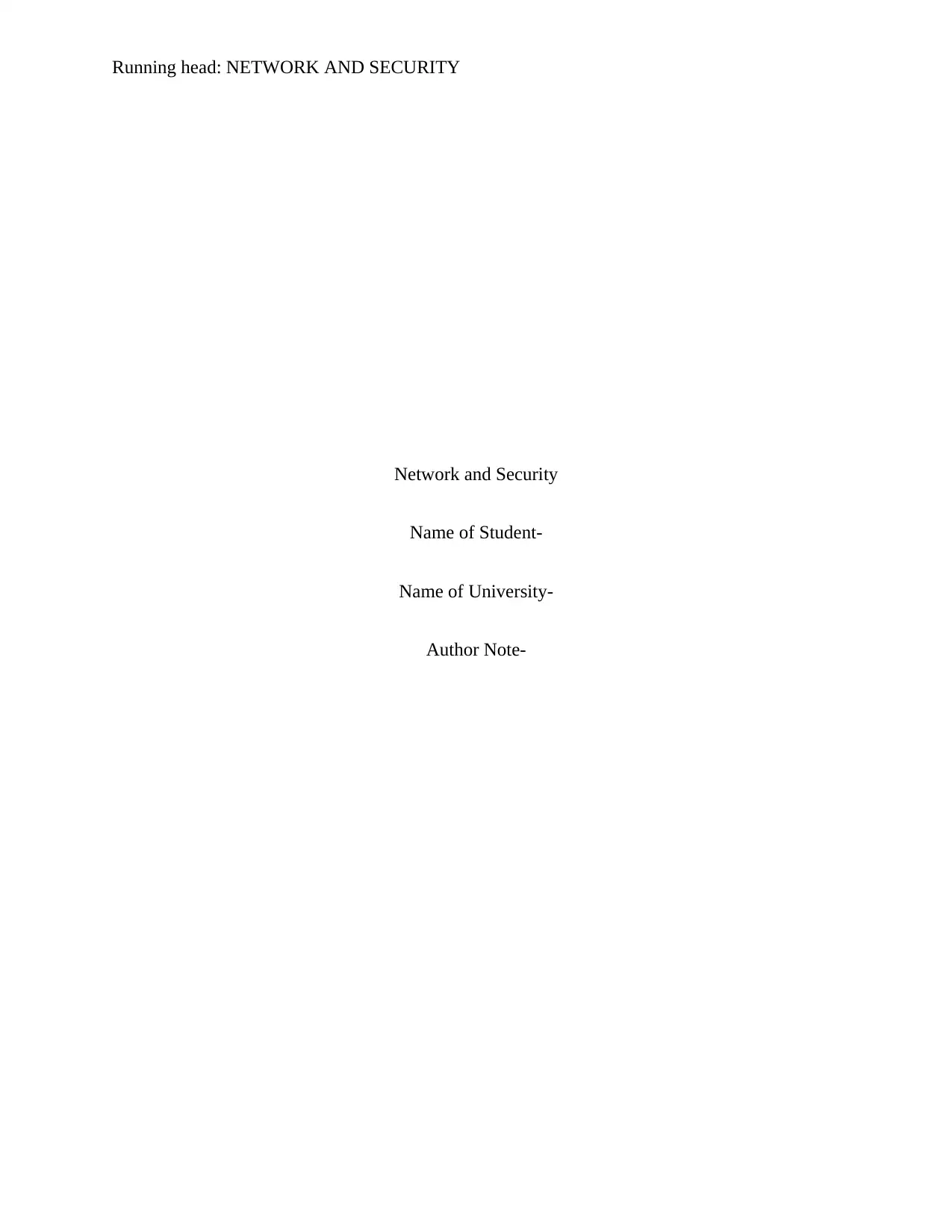
Running head: NETWORK AND SECURITY
Network and Security
Name of Student-
Name of University-
Author Note-
Network and Security
Name of Student-
Name of University-
Author Note-
Paraphrase This Document
Need a fresh take? Get an instant paraphrase of this document with our AI Paraphraser
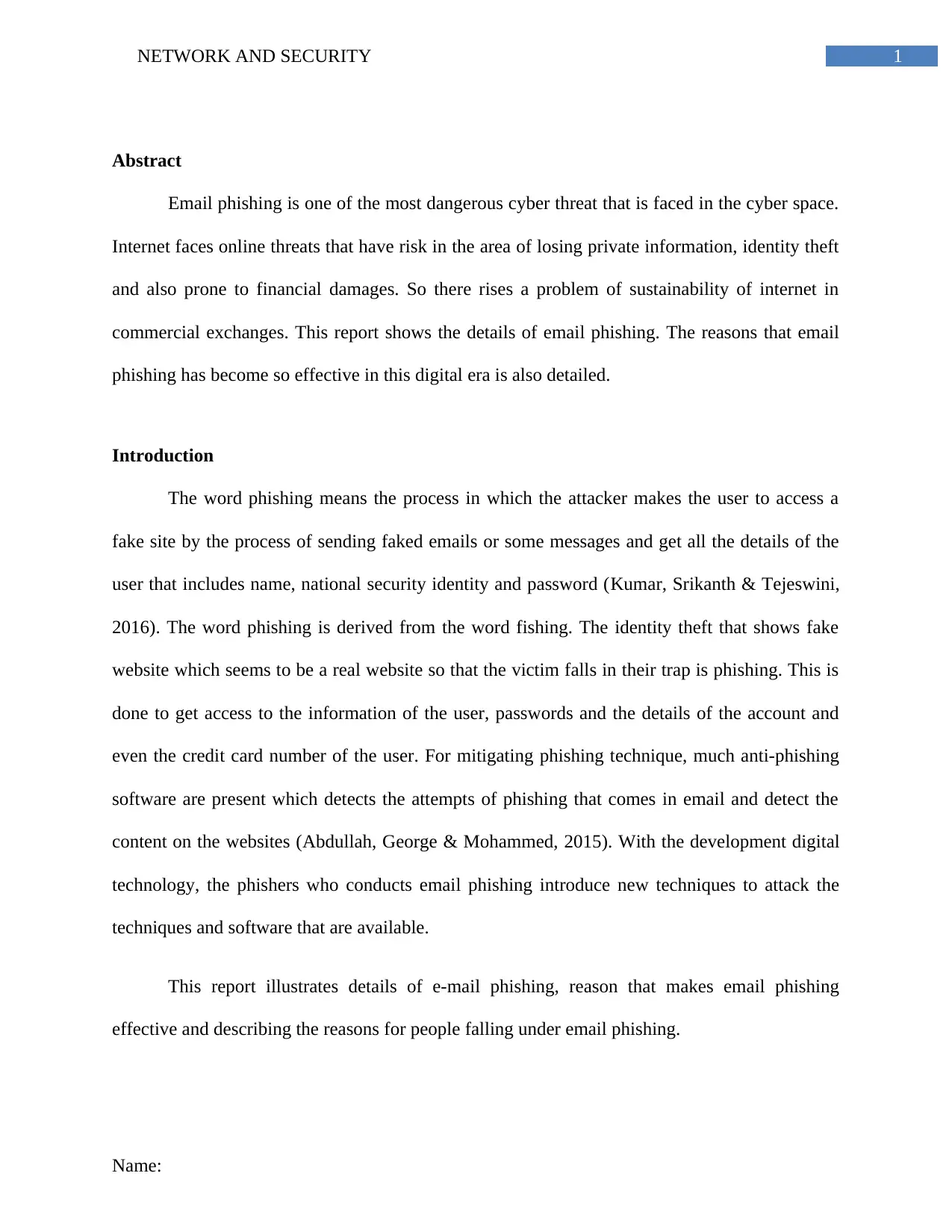
1NETWORK AND SECURITY
Abstract
Email phishing is one of the most dangerous cyber threat that is faced in the cyber space.
Internet faces online threats that have risk in the area of losing private information, identity theft
and also prone to financial damages. So there rises a problem of sustainability of internet in
commercial exchanges. This report shows the details of email phishing. The reasons that email
phishing has become so effective in this digital era is also detailed.
Introduction
The word phishing means the process in which the attacker makes the user to access a
fake site by the process of sending faked emails or some messages and get all the details of the
user that includes name, national security identity and password (Kumar, Srikanth & Tejeswini,
2016). The word phishing is derived from the word fishing. The identity theft that shows fake
website which seems to be a real website so that the victim falls in their trap is phishing. This is
done to get access to the information of the user, passwords and the details of the account and
even the credit card number of the user. For mitigating phishing technique, much anti-phishing
software are present which detects the attempts of phishing that comes in email and detect the
content on the websites (Abdullah, George & Mohammed, 2015). With the development digital
technology, the phishers who conducts email phishing introduce new techniques to attack the
techniques and software that are available.
This report illustrates details of e-mail phishing, reason that makes email phishing
effective and describing the reasons for people falling under email phishing.
Name:
Abstract
Email phishing is one of the most dangerous cyber threat that is faced in the cyber space.
Internet faces online threats that have risk in the area of losing private information, identity theft
and also prone to financial damages. So there rises a problem of sustainability of internet in
commercial exchanges. This report shows the details of email phishing. The reasons that email
phishing has become so effective in this digital era is also detailed.
Introduction
The word phishing means the process in which the attacker makes the user to access a
fake site by the process of sending faked emails or some messages and get all the details of the
user that includes name, national security identity and password (Kumar, Srikanth & Tejeswini,
2016). The word phishing is derived from the word fishing. The identity theft that shows fake
website which seems to be a real website so that the victim falls in their trap is phishing. This is
done to get access to the information of the user, passwords and the details of the account and
even the credit card number of the user. For mitigating phishing technique, much anti-phishing
software are present which detects the attempts of phishing that comes in email and detect the
content on the websites (Abdullah, George & Mohammed, 2015). With the development digital
technology, the phishers who conducts email phishing introduce new techniques to attack the
techniques and software that are available.
This report illustrates details of e-mail phishing, reason that makes email phishing
effective and describing the reasons for people falling under email phishing.
Name:
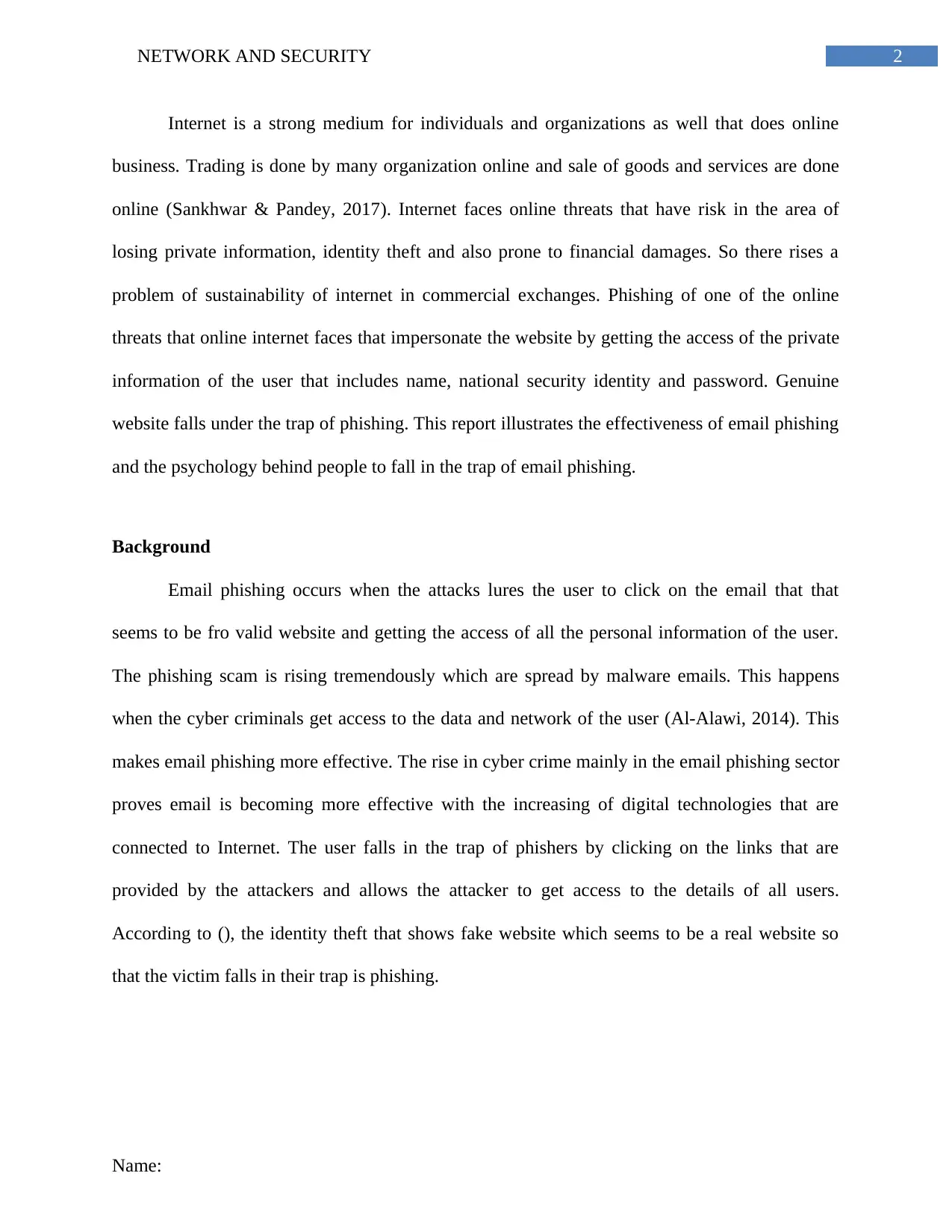
2NETWORK AND SECURITY
Internet is a strong medium for individuals and organizations as well that does online
business. Trading is done by many organization online and sale of goods and services are done
online (Sankhwar & Pandey, 2017). Internet faces online threats that have risk in the area of
losing private information, identity theft and also prone to financial damages. So there rises a
problem of sustainability of internet in commercial exchanges. Phishing of one of the online
threats that online internet faces that impersonate the website by getting the access of the private
information of the user that includes name, national security identity and password. Genuine
website falls under the trap of phishing. This report illustrates the effectiveness of email phishing
and the psychology behind people to fall in the trap of email phishing.
Background
Email phishing occurs when the attacks lures the user to click on the email that that
seems to be fro valid website and getting the access of all the personal information of the user.
The phishing scam is rising tremendously which are spread by malware emails. This happens
when the cyber criminals get access to the data and network of the user (Al-Alawi, 2014). This
makes email phishing more effective. The rise in cyber crime mainly in the email phishing sector
proves email is becoming more effective with the increasing of digital technologies that are
connected to Internet. The user falls in the trap of phishers by clicking on the links that are
provided by the attackers and allows the attacker to get access to the details of all users.
According to (), the identity theft that shows fake website which seems to be a real website so
that the victim falls in their trap is phishing.
Name:
Internet is a strong medium for individuals and organizations as well that does online
business. Trading is done by many organization online and sale of goods and services are done
online (Sankhwar & Pandey, 2017). Internet faces online threats that have risk in the area of
losing private information, identity theft and also prone to financial damages. So there rises a
problem of sustainability of internet in commercial exchanges. Phishing of one of the online
threats that online internet faces that impersonate the website by getting the access of the private
information of the user that includes name, national security identity and password. Genuine
website falls under the trap of phishing. This report illustrates the effectiveness of email phishing
and the psychology behind people to fall in the trap of email phishing.
Background
Email phishing occurs when the attacks lures the user to click on the email that that
seems to be fro valid website and getting the access of all the personal information of the user.
The phishing scam is rising tremendously which are spread by malware emails. This happens
when the cyber criminals get access to the data and network of the user (Al-Alawi, 2014). This
makes email phishing more effective. The rise in cyber crime mainly in the email phishing sector
proves email is becoming more effective with the increasing of digital technologies that are
connected to Internet. The user falls in the trap of phishers by clicking on the links that are
provided by the attackers and allows the attacker to get access to the details of all users.
According to (), the identity theft that shows fake website which seems to be a real website so
that the victim falls in their trap is phishing.
Name:
⊘ This is a preview!⊘
Do you want full access?
Subscribe today to unlock all pages.

Trusted by 1+ million students worldwide
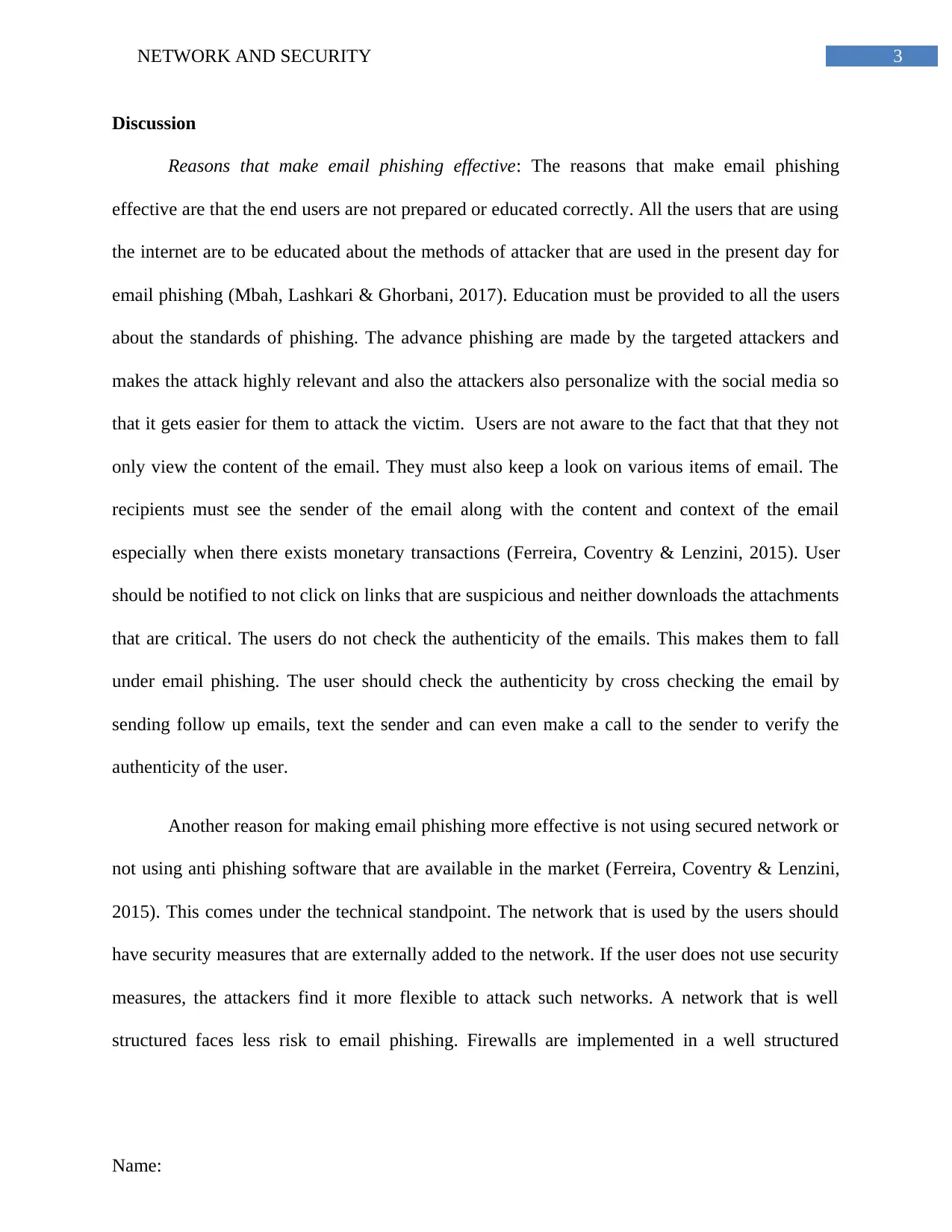
3NETWORK AND SECURITY
Discussion
Reasons that make email phishing effective: The reasons that make email phishing
effective are that the end users are not prepared or educated correctly. All the users that are using
the internet are to be educated about the methods of attacker that are used in the present day for
email phishing (Mbah, Lashkari & Ghorbani, 2017). Education must be provided to all the users
about the standards of phishing. The advance phishing are made by the targeted attackers and
makes the attack highly relevant and also the attackers also personalize with the social media so
that it gets easier for them to attack the victim. Users are not aware to the fact that that they not
only view the content of the email. They must also keep a look on various items of email. The
recipients must see the sender of the email along with the content and context of the email
especially when there exists monetary transactions (Ferreira, Coventry & Lenzini, 2015). User
should be notified to not click on links that are suspicious and neither downloads the attachments
that are critical. The users do not check the authenticity of the emails. This makes them to fall
under email phishing. The user should check the authenticity by cross checking the email by
sending follow up emails, text the sender and can even make a call to the sender to verify the
authenticity of the user.
Another reason for making email phishing more effective is not using secured network or
not using anti phishing software that are available in the market (Ferreira, Coventry & Lenzini,
2015). This comes under the technical standpoint. The network that is used by the users should
have security measures that are externally added to the network. If the user does not use security
measures, the attackers find it more flexible to attack such networks. A network that is well
structured faces less risk to email phishing. Firewalls are implemented in a well structured
Name:
Discussion
Reasons that make email phishing effective: The reasons that make email phishing
effective are that the end users are not prepared or educated correctly. All the users that are using
the internet are to be educated about the methods of attacker that are used in the present day for
email phishing (Mbah, Lashkari & Ghorbani, 2017). Education must be provided to all the users
about the standards of phishing. The advance phishing are made by the targeted attackers and
makes the attack highly relevant and also the attackers also personalize with the social media so
that it gets easier for them to attack the victim. Users are not aware to the fact that that they not
only view the content of the email. They must also keep a look on various items of email. The
recipients must see the sender of the email along with the content and context of the email
especially when there exists monetary transactions (Ferreira, Coventry & Lenzini, 2015). User
should be notified to not click on links that are suspicious and neither downloads the attachments
that are critical. The users do not check the authenticity of the emails. This makes them to fall
under email phishing. The user should check the authenticity by cross checking the email by
sending follow up emails, text the sender and can even make a call to the sender to verify the
authenticity of the user.
Another reason for making email phishing more effective is not using secured network or
not using anti phishing software that are available in the market (Ferreira, Coventry & Lenzini,
2015). This comes under the technical standpoint. The network that is used by the users should
have security measures that are externally added to the network. If the user does not use security
measures, the attackers find it more flexible to attack such networks. A network that is well
structured faces less risk to email phishing. Firewalls are implemented in a well structured
Name:
Paraphrase This Document
Need a fresh take? Get an instant paraphrase of this document with our AI Paraphraser
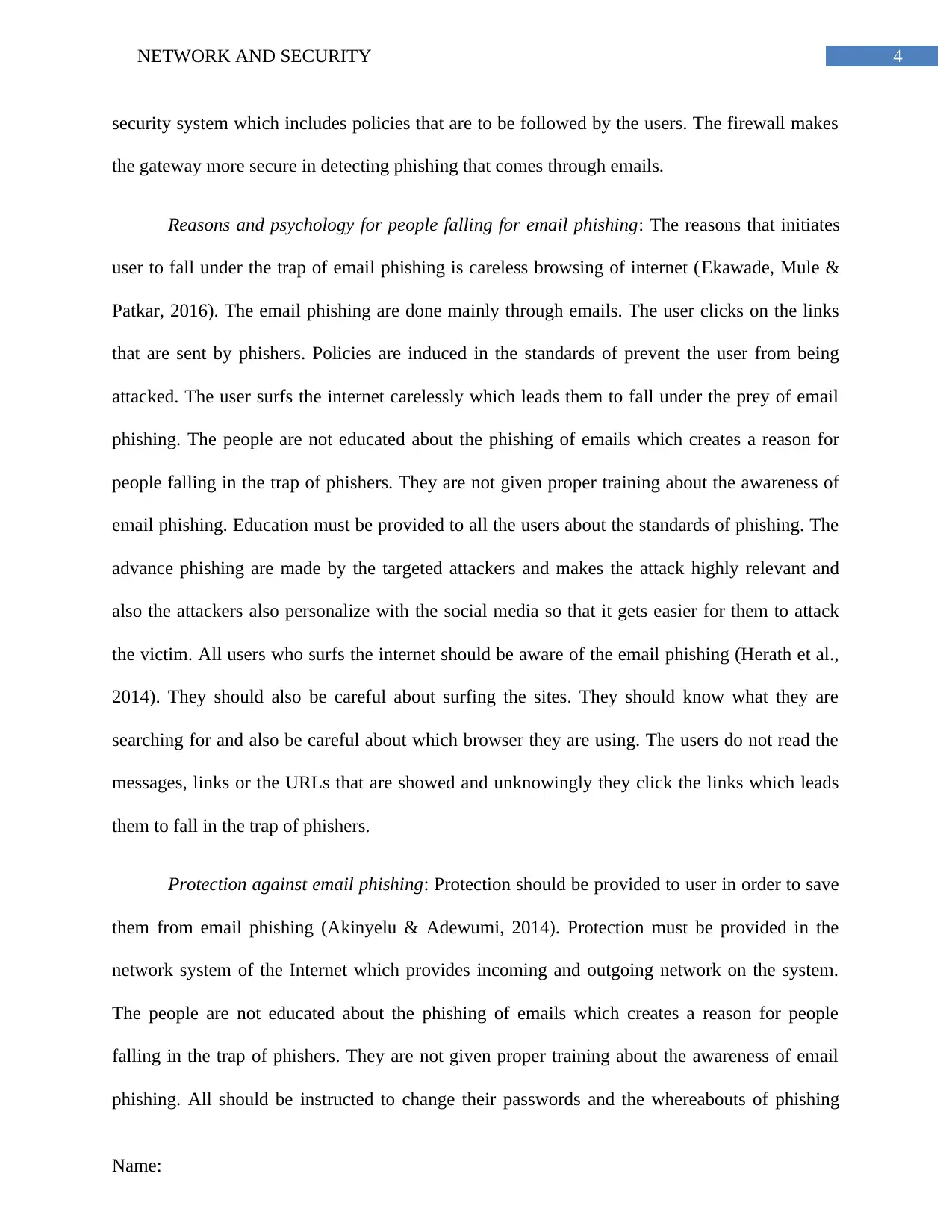
4NETWORK AND SECURITY
security system which includes policies that are to be followed by the users. The firewall makes
the gateway more secure in detecting phishing that comes through emails.
Reasons and psychology for people falling for email phishing: The reasons that initiates
user to fall under the trap of email phishing is careless browsing of internet (Ekawade, Mule &
Patkar, 2016). The email phishing are done mainly through emails. The user clicks on the links
that are sent by phishers. Policies are induced in the standards of prevent the user from being
attacked. The user surfs the internet carelessly which leads them to fall under the prey of email
phishing. The people are not educated about the phishing of emails which creates a reason for
people falling in the trap of phishers. They are not given proper training about the awareness of
email phishing. Education must be provided to all the users about the standards of phishing. The
advance phishing are made by the targeted attackers and makes the attack highly relevant and
also the attackers also personalize with the social media so that it gets easier for them to attack
the victim. All users who surfs the internet should be aware of the email phishing (Herath et al.,
2014). They should also be careful about surfing the sites. They should know what they are
searching for and also be careful about which browser they are using. The users do not read the
messages, links or the URLs that are showed and unknowingly they click the links which leads
them to fall in the trap of phishers.
Protection against email phishing: Protection should be provided to user in order to save
them from email phishing (Akinyelu & Adewumi, 2014). Protection must be provided in the
network system of the Internet which provides incoming and outgoing network on the system.
The people are not educated about the phishing of emails which creates a reason for people
falling in the trap of phishers. They are not given proper training about the awareness of email
phishing. All should be instructed to change their passwords and the whereabouts of phishing
Name:
security system which includes policies that are to be followed by the users. The firewall makes
the gateway more secure in detecting phishing that comes through emails.
Reasons and psychology for people falling for email phishing: The reasons that initiates
user to fall under the trap of email phishing is careless browsing of internet (Ekawade, Mule &
Patkar, 2016). The email phishing are done mainly through emails. The user clicks on the links
that are sent by phishers. Policies are induced in the standards of prevent the user from being
attacked. The user surfs the internet carelessly which leads them to fall under the prey of email
phishing. The people are not educated about the phishing of emails which creates a reason for
people falling in the trap of phishers. They are not given proper training about the awareness of
email phishing. Education must be provided to all the users about the standards of phishing. The
advance phishing are made by the targeted attackers and makes the attack highly relevant and
also the attackers also personalize with the social media so that it gets easier for them to attack
the victim. All users who surfs the internet should be aware of the email phishing (Herath et al.,
2014). They should also be careful about surfing the sites. They should know what they are
searching for and also be careful about which browser they are using. The users do not read the
messages, links or the URLs that are showed and unknowingly they click the links which leads
them to fall in the trap of phishers.
Protection against email phishing: Protection should be provided to user in order to save
them from email phishing (Akinyelu & Adewumi, 2014). Protection must be provided in the
network system of the Internet which provides incoming and outgoing network on the system.
The people are not educated about the phishing of emails which creates a reason for people
falling in the trap of phishers. They are not given proper training about the awareness of email
phishing. All should be instructed to change their passwords and the whereabouts of phishing
Name:
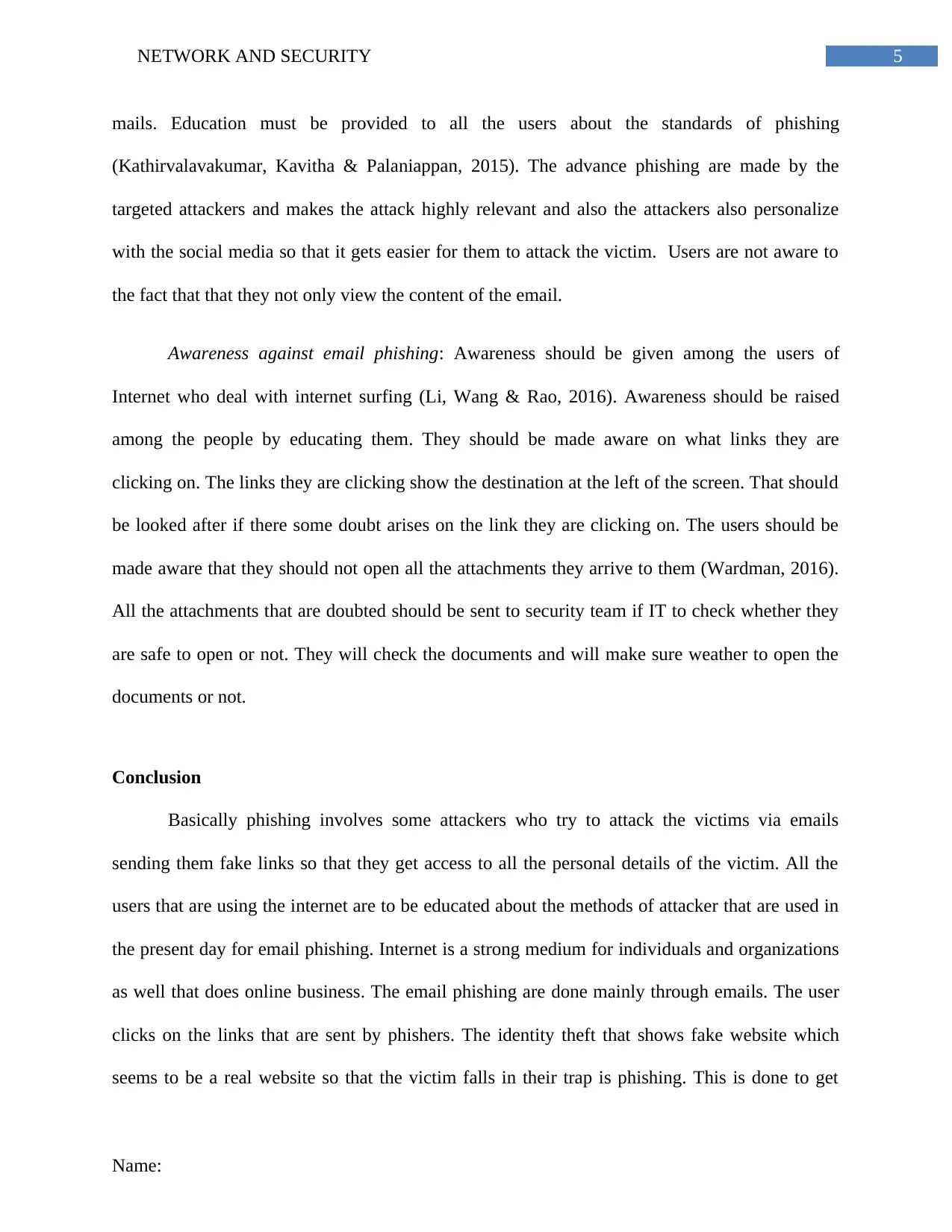
5NETWORK AND SECURITY
mails. Education must be provided to all the users about the standards of phishing
(Kathirvalavakumar, Kavitha & Palaniappan, 2015). The advance phishing are made by the
targeted attackers and makes the attack highly relevant and also the attackers also personalize
with the social media so that it gets easier for them to attack the victim. Users are not aware to
the fact that that they not only view the content of the email.
Awareness against email phishing: Awareness should be given among the users of
Internet who deal with internet surfing (Li, Wang & Rao, 2016). Awareness should be raised
among the people by educating them. They should be made aware on what links they are
clicking on. The links they are clicking show the destination at the left of the screen. That should
be looked after if there some doubt arises on the link they are clicking on. The users should be
made aware that they should not open all the attachments they arrive to them (Wardman, 2016).
All the attachments that are doubted should be sent to security team if IT to check whether they
are safe to open or not. They will check the documents and will make sure weather to open the
documents or not.
Conclusion
Basically phishing involves some attackers who try to attack the victims via emails
sending them fake links so that they get access to all the personal details of the victim. All the
users that are using the internet are to be educated about the methods of attacker that are used in
the present day for email phishing. Internet is a strong medium for individuals and organizations
as well that does online business. The email phishing are done mainly through emails. The user
clicks on the links that are sent by phishers. The identity theft that shows fake website which
seems to be a real website so that the victim falls in their trap is phishing. This is done to get
Name:
mails. Education must be provided to all the users about the standards of phishing
(Kathirvalavakumar, Kavitha & Palaniappan, 2015). The advance phishing are made by the
targeted attackers and makes the attack highly relevant and also the attackers also personalize
with the social media so that it gets easier for them to attack the victim. Users are not aware to
the fact that that they not only view the content of the email.
Awareness against email phishing: Awareness should be given among the users of
Internet who deal with internet surfing (Li, Wang & Rao, 2016). Awareness should be raised
among the people by educating them. They should be made aware on what links they are
clicking on. The links they are clicking show the destination at the left of the screen. That should
be looked after if there some doubt arises on the link they are clicking on. The users should be
made aware that they should not open all the attachments they arrive to them (Wardman, 2016).
All the attachments that are doubted should be sent to security team if IT to check whether they
are safe to open or not. They will check the documents and will make sure weather to open the
documents or not.
Conclusion
Basically phishing involves some attackers who try to attack the victims via emails
sending them fake links so that they get access to all the personal details of the victim. All the
users that are using the internet are to be educated about the methods of attacker that are used in
the present day for email phishing. Internet is a strong medium for individuals and organizations
as well that does online business. The email phishing are done mainly through emails. The user
clicks on the links that are sent by phishers. The identity theft that shows fake website which
seems to be a real website so that the victim falls in their trap is phishing. This is done to get
Name:
⊘ This is a preview!⊘
Do you want full access?
Subscribe today to unlock all pages.

Trusted by 1+ million students worldwide
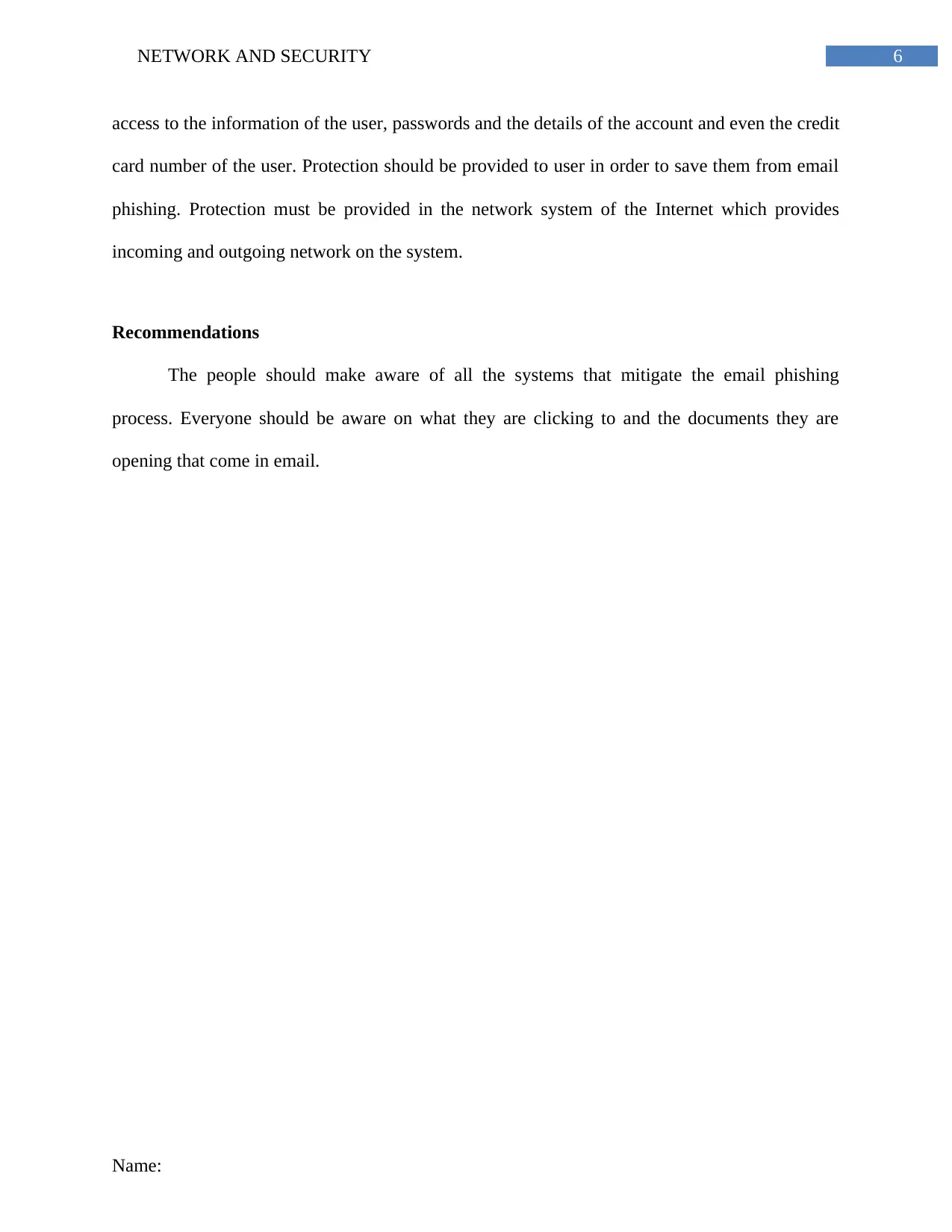
6NETWORK AND SECURITY
access to the information of the user, passwords and the details of the account and even the credit
card number of the user. Protection should be provided to user in order to save them from email
phishing. Protection must be provided in the network system of the Internet which provides
incoming and outgoing network on the system.
Recommendations
The people should make aware of all the systems that mitigate the email phishing
process. Everyone should be aware on what they are clicking to and the documents they are
opening that come in email.
Name:
access to the information of the user, passwords and the details of the account and even the credit
card number of the user. Protection should be provided to user in order to save them from email
phishing. Protection must be provided in the network system of the Internet which provides
incoming and outgoing network on the system.
Recommendations
The people should make aware of all the systems that mitigate the email phishing
process. Everyone should be aware on what they are clicking to and the documents they are
opening that come in email.
Name:
Paraphrase This Document
Need a fresh take? Get an instant paraphrase of this document with our AI Paraphraser
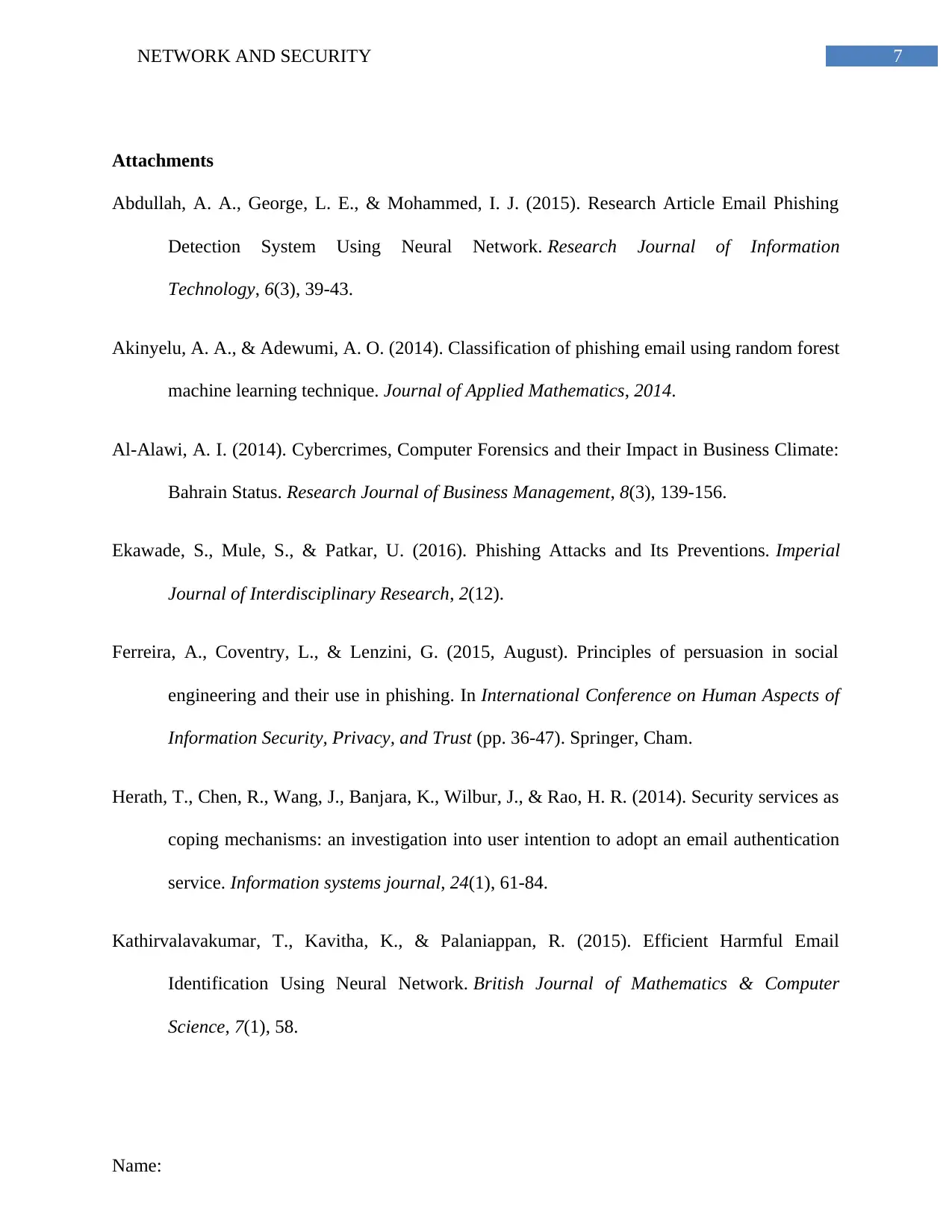
7NETWORK AND SECURITY
Attachments
Abdullah, A. A., George, L. E., & Mohammed, I. J. (2015). Research Article Email Phishing
Detection System Using Neural Network. Research Journal of Information
Technology, 6(3), 39-43.
Akinyelu, A. A., & Adewumi, A. O. (2014). Classification of phishing email using random forest
machine learning technique. Journal of Applied Mathematics, 2014.
Al-Alawi, A. I. (2014). Cybercrimes, Computer Forensics and their Impact in Business Climate:
Bahrain Status. Research Journal of Business Management, 8(3), 139-156.
Ekawade, S., Mule, S., & Patkar, U. (2016). Phishing Attacks and Its Preventions. Imperial
Journal of Interdisciplinary Research, 2(12).
Ferreira, A., Coventry, L., & Lenzini, G. (2015, August). Principles of persuasion in social
engineering and their use in phishing. In International Conference on Human Aspects of
Information Security, Privacy, and Trust (pp. 36-47). Springer, Cham.
Herath, T., Chen, R., Wang, J., Banjara, K., Wilbur, J., & Rao, H. R. (2014). Security services as
coping mechanisms: an investigation into user intention to adopt an email authentication
service. Information systems journal, 24(1), 61-84.
Kathirvalavakumar, T., Kavitha, K., & Palaniappan, R. (2015). Efficient Harmful Email
Identification Using Neural Network. British Journal of Mathematics & Computer
Science, 7(1), 58.
Name:
Attachments
Abdullah, A. A., George, L. E., & Mohammed, I. J. (2015). Research Article Email Phishing
Detection System Using Neural Network. Research Journal of Information
Technology, 6(3), 39-43.
Akinyelu, A. A., & Adewumi, A. O. (2014). Classification of phishing email using random forest
machine learning technique. Journal of Applied Mathematics, 2014.
Al-Alawi, A. I. (2014). Cybercrimes, Computer Forensics and their Impact in Business Climate:
Bahrain Status. Research Journal of Business Management, 8(3), 139-156.
Ekawade, S., Mule, S., & Patkar, U. (2016). Phishing Attacks and Its Preventions. Imperial
Journal of Interdisciplinary Research, 2(12).
Ferreira, A., Coventry, L., & Lenzini, G. (2015, August). Principles of persuasion in social
engineering and their use in phishing. In International Conference on Human Aspects of
Information Security, Privacy, and Trust (pp. 36-47). Springer, Cham.
Herath, T., Chen, R., Wang, J., Banjara, K., Wilbur, J., & Rao, H. R. (2014). Security services as
coping mechanisms: an investigation into user intention to adopt an email authentication
service. Information systems journal, 24(1), 61-84.
Kathirvalavakumar, T., Kavitha, K., & Palaniappan, R. (2015). Efficient Harmful Email
Identification Using Neural Network. British Journal of Mathematics & Computer
Science, 7(1), 58.
Name:
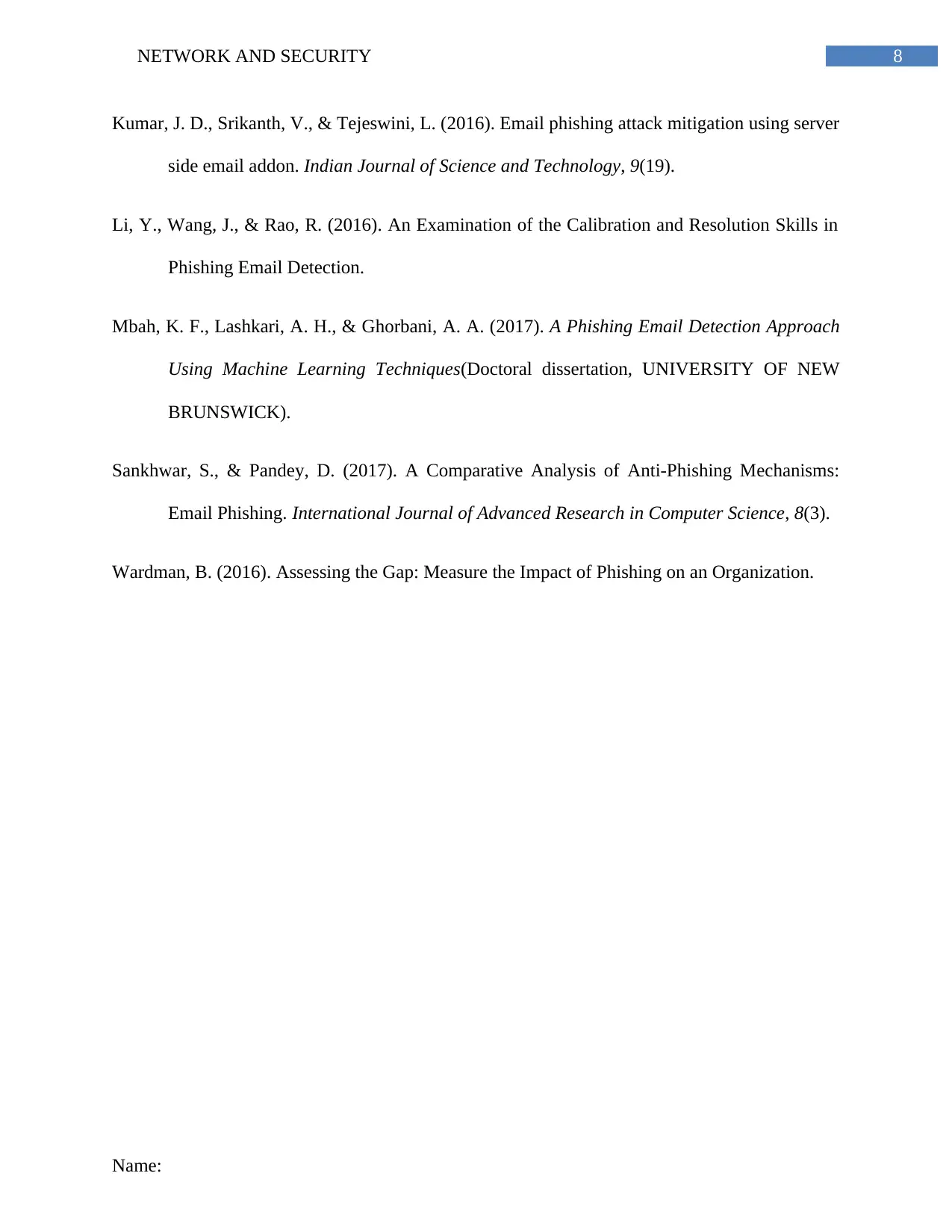
8NETWORK AND SECURITY
Kumar, J. D., Srikanth, V., & Tejeswini, L. (2016). Email phishing attack mitigation using server
side email addon. Indian Journal of Science and Technology, 9(19).
Li, Y., Wang, J., & Rao, R. (2016). An Examination of the Calibration and Resolution Skills in
Phishing Email Detection.
Mbah, K. F., Lashkari, A. H., & Ghorbani, A. A. (2017). A Phishing Email Detection Approach
Using Machine Learning Techniques(Doctoral dissertation, UNIVERSITY OF NEW
BRUNSWICK).
Sankhwar, S., & Pandey, D. (2017). A Comparative Analysis of Anti-Phishing Mechanisms:
Email Phishing. International Journal of Advanced Research in Computer Science, 8(3).
Wardman, B. (2016). Assessing the Gap: Measure the Impact of Phishing on an Organization.
Name:
Kumar, J. D., Srikanth, V., & Tejeswini, L. (2016). Email phishing attack mitigation using server
side email addon. Indian Journal of Science and Technology, 9(19).
Li, Y., Wang, J., & Rao, R. (2016). An Examination of the Calibration and Resolution Skills in
Phishing Email Detection.
Mbah, K. F., Lashkari, A. H., & Ghorbani, A. A. (2017). A Phishing Email Detection Approach
Using Machine Learning Techniques(Doctoral dissertation, UNIVERSITY OF NEW
BRUNSWICK).
Sankhwar, S., & Pandey, D. (2017). A Comparative Analysis of Anti-Phishing Mechanisms:
Email Phishing. International Journal of Advanced Research in Computer Science, 8(3).
Wardman, B. (2016). Assessing the Gap: Measure the Impact of Phishing on an Organization.
Name:
⊘ This is a preview!⊘
Do you want full access?
Subscribe today to unlock all pages.

Trusted by 1+ million students worldwide
1 out of 9
Related Documents
Your All-in-One AI-Powered Toolkit for Academic Success.
+13062052269
info@desklib.com
Available 24*7 on WhatsApp / Email
![[object Object]](/_next/static/media/star-bottom.7253800d.svg)
Unlock your academic potential
Copyright © 2020–2025 A2Z Services. All Rights Reserved. Developed and managed by ZUCOL.





